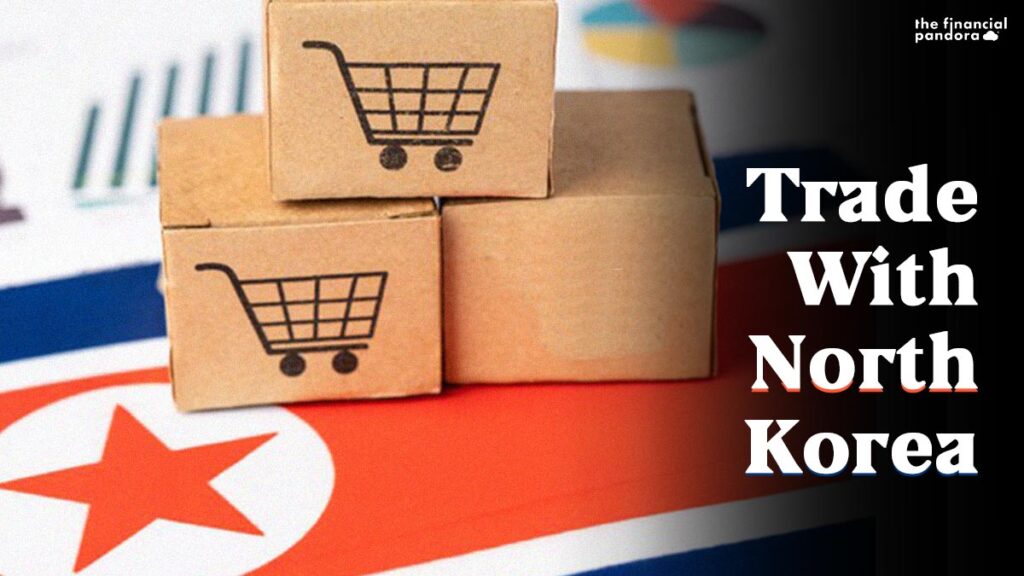For many, the thoughts of North Korea are often directed to ideas that relate to a hermit nation, redundant technology, an authoritarian regime, and obviously, the one and only Kim Jong Un. However, more to the 73-year old state is located far to the east in the Korean Peninsula, sharing borders with Russia, China, and South Korea.

A little on the deem-to-be rogue nation
The Democratic People’s Republic of Korea, also DPRK, is a socialist state with a centrally planned economy. Using the term “centrally planned” stands for a state-wide economic system, this being in sync with their socialist nature. Over the overs with the Kim dynasty in power, North Korea can be termed a nation under a totalitarian dictatorship.
Apart from the generic ties with its nuclear status, frequent mentions of Kim Jong Un, and mentions of harsh punishments, the nation is home to 2.5 crores North Koreans, a bulk of minerals, natural beauty, and rich historical culture.
What does the external trade look like?
DPRK follows the ideology of “Juche,” meaning the nation’s factors and means of production are state-owned. Housing, healthcare, and education are essential services provided by the state to the public. The political and economic principles prevailing have resulted in the form assuming the title of autarky. The government highly favors the concept of self-sufficiency; however, at the same time, it can prove to be strenuous to the public. Since 2012, with Jong Un in power, there has been rising hope for foreign traders to enter markets and procure goods from DPRK, though these practices have been limited. The dilution of strong traditional trade ideologies is not easy for a state like this. This rigidity combined with humanitarian and sanction-based pressures has led to a deteriorating external trade.
It is a known fact that military operations stand first in North Korea, in the 1970s the situation was worse. Spendings were used to push heavy military modernisation leaving the country greatly indebted, and with the collapse of the Eastern Bloc in the 1990s, the need for inclusion of a less restrictive foreign trade was imperative. The country still makes significant investments into its military, and some analysts claim that this expense may come at the cost of its economic development. In 2016, the last year for which estimates were available, North Korea spent an estimated $4 billion, or approximately 24% of its GDP, on defense spending.

Today, with limited outside trade, the country’s main exports include commodities like metallurgical products, minerals, manufactured products, textiles, and agricultural and fishery products. Growing interest of the outsiders has led to tourism contributing to the country’s reserves. The state largely depends on imports of items like petroleum, cooking coal, machinery, equipment, textiles, and grains.
As of today, North Korea’s largest trade partner in China. China remains to be DPRK’s largest and the most important trade partner, specially under Kim’s regime. Pyongyang has received economic support from the nation since the Korean War. It increased tenfold between 2000 and 2015, peaking in 2014 at $ 6.86 billion. However, the recent nuclear tests, which led to a strain in the relation and imposition of sanctions combined with the onslaught of the Covid-19 pandemic, trade between the two countries has borne the brunt. It dropped severely last year as North Korea sealed off its borders. Bilateral trade in March surpassed $10 million for the first time in six months, according to the Seoul-based Korea International Trade Association, though it is a tiny fraction of pre-sanctions levels. As compared to China, Russia does not have major trade ties with North Korea. Even with heavy sanctions, Russia imported $2.3 million in goods from North Korea from January-November 2019, up from $1.9 million in 2018.
It would be a surprise to many, but North Korea also has relatively considerable trade ties with India. The export value summed up to $ 2.87 million in 2019, these include exports of reaction and catalysts products, raw zinc and disc chemicals. Other nations on the receiving end consist of Ghana, Suriname, Costa Rica, Saudi Arabia, and Fiji.
The North Korean imports greatly outweigh the export figures, which portrays major problems with the autarky ideology. It heavily depends on China for textile, medical and chemical products, grains, fruits, furniture, and certain metals. The imports from China summed up to $ 2.59 billion in 2019. Russia, India, Brazil, and Honduras come next in line as top import nations.
Apart from the formal trade…
With North Korea trade arrangements are never too complex, the formal trade may be suffering a strained phase, but the illicit trades (drugs, forging banknotes, cryptocurrencies) continue to keep the pockets of the North Korean elites heavy. The country has a long history with domestic black markets which simultaneously helped the impoverished locals to get by.
However, this is not where it stops, DPRK is not just sending its products abroad, but has gone one step further and opened restaurants. Keen to monetise its popular cuisine and style of entertainment, the North Korean government has opened over 100, all called Pyongyang after the country’s capital – across China and Thailand, Vietnam, and even the Netherlands.
Foreign trade has no doubt helped us understand this enigmatic state a little further, but with North Korea, we only understand what they want us to know. A lot of the facts known about the country are nothing but fabrications that have led governments and bodies around the world to construct an image accordingly. However, with recent revelations by the Great Leader himself about the slipping economy, poverty, food shortages, and the cautious attempt to keep the nuclear status guarded, external trade is bound to suffer. This raises questions regarding payments and acceptance in foreign currencies (an area to explore for some other time) and ultimately how does one manage an economy as damaged as this. Mysteries still lie in suspicious cargo movements of foreign ships near the country and the luxury designer wear adorned by the elites and Kim himself. It is puzzling that a fraction of the country is exposed to the rest of the world whereas the rest still resides in the dark with rumours of deadly famines, a failing economy, and perpetual poverty. With suspicions about Kim’s failing health only add to the world’s curiosity about the state’s succession plan and what it would actually mean for trade with the country.
For sources click here
Follow Us @
Sources:
- Chinese trade provides boost to North Korea’s battered economy
- Government & Policy How the North Korean Economy Works
- Wikipedia – Economy of North Korea
- North Korea (PRK) Exports, Imports, and Trade Partners
- North Korean Economy Watch
- Chart: Who Is North Korea Trading With?
- Map of North Korea’s Imports and Exports | NK PRO
- How North Korea makes money revealed | lovemoney.com
- Five ways North Korea gets money to build nuclear weapons
- How does North Korea make its money?
- 9 mind-blowing facts about North Korea’s economy
- Cash-strapped North Korea seeks new sources of income
- North Korea’s External Economic Relations (Paper) | PIIE
- Russia-North Korea Trade-Up Despite Sanctions, Reports Say




